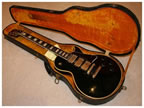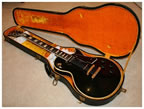The Les Paul Custom is arguably one of the more controversial guitars in
the Les Paul lineup, in that players and collectors always seem to have
divided opinions about the desirability of this model. This article is an
abbreviated summary of facts and observations about the Les Paul Custom
from various books and documents regarding the model, as well as the author’s
observations as an owner of two vintage Customs. |

|
Cllck images to enlarge
The Les
Paul Custom debuted in 1954 (some references say late 1953) in an attempt
to broaden the solid body product line after the initial success of
the Les Paul Model gold top. Les Paul claimed that he suggested black
as the color for the guitar because it looked classy and went well with
a black Tuxedo on stage.
|
|
| |
 |
The
first price list of September 1, 1954 called it the “Les Paul Deluxe,”
at a list price of $325, a full $100 more than the Les Paul (goldtop) Model.
The term “Custom” soon replaced “Deluxe,” as noted
on the truss rod cover. |
|
|
The Les Paul Custom differed greatly from the Les Paul Model in several
ways. It had a solid Honduras mahogany body, which gave it a mellower
tone than the maple capped Les Paul Model. It came with a dark ebony fret
board with rectangular pearloid inlays, a wider, bound headstock with
the Super 400’s style split diamond inlay, gold plated hardware,
seven-ply top binding on top of body, five-ply binding on back of body
and around the headstock, and three ply pickguard. The Custom was the
first Les Paul model to receive the Tune-o-Matic bridge. It was equipped
with very low, flat frets for fast playing action. The Gibson catalog
said that “players rave about its extremely low smooth frets and
playing action, calling it the ‘Fretless Wonder.’” Tuners
were specified as “gold plated Sealfast individual machine heads
with deluxe (tulip style) buttons.” It was introduced with speed
knobs, which changed over to the top hat style in approximately 1956.
The serial number was inked in white on the back of the headstock.
|

|
|
|
| The
Custom was issued with the unique Alnico V pickup in the neck position that
was designed by Seth Lover during 1952/53 and installed in Super 400s and
L-5s. It was designed by Seth to be louder than the P-90 in the bridge position.
Lover said that he designed the pole pieces in the alnico pickup to be rectangular
so that it looked different from other pickups and would also allow the
placement of screws in between the pole pieces for height adjustment. Many
players would inadvertently adjust the pole pieces too close to the strings,
thereby negatively affecting the tone. |
| |
The
first version of the Les Paul Custom lasted until mid 1957, when the second
version of model was converted to three humbucking patent-applied-for (PAF)
pickups. The middle position on the pickup selector switch is for the bridge
and middle pickups, which are wired out of phase. There were a few two pickup
PAF models made, but there are no records available as to how many two pickups
versions were produced. A March, 1958 price list puts the Custom at $375,
at the same time that the Les Paul Model was $247.50. The humbucker-equipped
Les Paul Custom was available until 1960 according to shipping records,
although there are a few examples with early 1961 serial numbers. Gold plated
Grover tuners were introduced in late 1958.
|
| |
|
|
| |
|
For
both versions of the Custom, the standard case, made by Lifton, was a
black pebble style covering with gold interior lining. |
|
|
There were
1,912 Les Paul Customs shipped from 1954 through 1960, in contrast with
9,557 Les Paul Model/Les Paul Standards shipped from 1952-1960.
A few observations
are provided by the author on his “first version” Alnico/P-90
1957 Custom and “second version” PAF equipped 1958 Custom.
The 1957
Alnico/P-90 Custom is relatively light, at 8-1/2 pounds, and is a very
resonant guitar and delightful to play. While it has original fretless
wonder frets, string bending is possible and the guitar feels good. The
Alnico pickup in the neck, at 8.17 ohms, is very full sounding and articulate
yet throaty sounding, depending on the playing style and volume adjustment.
The P-90 bridge pickup is 8.08 ohms. |
| The
1958 PAF Custom is also relatively light, at 9-1/2 pounds, especially
when one considers that it has an additional pickup and Grovers. The neck
pickup is 8.14 ohms and bridge is 7.98 ohms. Three pickups Customs can
be challenging to play due to picking with the middle pickup in the way.
Lowering the height adjustment of the middle pickup of this guitar can
help, but it adversely affects the tone of the middle selector switch
position, which already has less volume due to the out-of-phase wiring
of the middle and bridge pickups. The tone capacitors used in this guitar
are original Sprague “phonebook” caps. The guitar sounds great
in the neck position and good in the bridge position. The middle position
is an “acquired taste.” |
| |
| The
Les Paul Custom has historically not been as desirable a model among players/collectors
in the vintage marketplace as the Les Paul Model (P-90 Goldtop versions)
and Les Paul Standard, presumably due to many subjective and objective factors,
including the challenge with the “fretless wonder” frets for
string bending, less interest in three-pickup guitars, not as much use of
the model among major “guitar heroes,” perception that it is
more of a jazz guitar, etc. Thus, pricing has been lower than that of comparable
Les Paul Goldtops and Standards. Rise in pricing on Customs has tended to
shadow the rise in prices for Les Paul Goldtops and Standards, although
the values on Customs seem to be more volatile after the 2003-2006 period
of rapid vintage guitar price rise and subsequent 2007-2008 market adjustment
that has occurred. |
| |
| The
Les Paul Custom has a unique place in the history and lineage of Gibson
solid body guitars, with a large contingent of die-hard loyalists. Both
versions of the Custom have a unique look, unique tone with their all-mahogany
bodies, and unique electronics and voicing with the Alnico V pickup in
the first version and the three humbuckers in the second version. There
has been enough interest in and love for Les Paul Customs to warrant multiple
versions of the guitar to be introduced after 1960/61, including the reintroduction
of the Les Paul in 1968 and well beyond to the present day.
|
| |
| NOTE:
As a member of the Les Paul Forum, I am always interested in learning
new things about the details and history of Gibson Guitars. Thus, I appreciate
any additional information or questions that readers may have about the
history of the Les Paul Custom or any other Gibson model. Please contact
me at MikeSlub@aol.com.
Credit
is given for references from “50 Years of the Gibson Les Paul”
Book by Tony Bacon, “Gibson Electrics” and “Gibson Electrics:
The Classic Years” by A.R. Duchossoir, “Gruhn’s Guide
to Vintage Guitars” by George Gruhn and Walter Carter, and “Gibson
Shipment Totals” by Larry Meiners.
Mike
Slubowski is a Gibson enthusiast, collector, player, and author, with
a special passion for Les Pauls.
This
article and photos are property of Mike Slubowski. No part of this article
may be reproduced without the expressed written permission of the author. |



